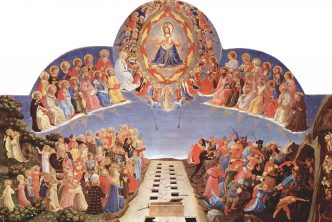This post features St. Teresa’s seminal work, The Interior Castle, included in every one of our base packages. A fuller body of St. Teresa of Ávila’s works are included in the Post-Reformation Catholic Thought and Piety collection, an amazing compilation of Post-Reformation Catholic thinkers and theologians currently 65% off until next friday.
St. Teresa of Ávila is one of the greatest post-Reformation thinkers and theologians of all time. In 1970, she was named the first female Doctor of the Church, and she, along with St. John of the Cross, is credited with founding the Discalced Carmelites.
Much of St. Teresa’s writing focuses on the concept of interiority, a theme that many monastics, including Thomas à Kempis, meditated on greatly. Perhaps her best-known work is her autobiography, The Life of Teresa of Jesus, but here I’d like to focus on her seminal work The Interior Castle (alternatively titled Las Moradas—“The Mansions”).

Reading through The Interior Castle, it is difficult to ignore the repeated instances of self-deprecation. Though it may be possible to understand Teresa’s constant deriding of herself as a consequence of her humble attitude, the way in which Teresa insults her own intelligence and person makes it seem as if she is going out of her way to make the audience aware of her many shortcomings. Comments such as “I am very ignorant and have poor wits”[1] and “I am very stupid”[2] are commonplace. Teresa is always criticizing her intelligence. But Teresa’s criticism goes beyond any mere critique of her own intellectual prowess; in her autobiography, Teresa often describes herself as a lowly “worm,”[3] a “wretched” creature;[4] one who is not worthy to live (and who often hates this life itself).
Yet Teresa’s criticism and misery do not terminate in a plea for pity. Teresa sees her wretchedness and the misery of this life as necessary parts of a process that leads toward eventual redemption. Indeed, one of the most vivid similes Teresa invokes comes midway through her book—that of the silkworm and the soul. For Teresa, the metamorphosis of the worm into the butterfly is one of the strangest and most beautiful signs in nature depicting the process of redemption within the human soul:
…certain little worms feed on luberry-leaves, till afterwards they become bigger, and then on the boughs they go spinning silk with their little mouths, and making little ce
lls very close, in which they are enclosed. From this cell or bag, which contains a large, but ugly worm that dies, there afterwards rises a white and very beautiful butterfly. If we had not seen this but had only heard of it as an old legend, who would believe it? Could we persuade ourselves that insects so utterly without the use of reason as a silkworm . . .should be so diligent and so industrious in toiling for our benefit?[5]
For Teresa, the silkworm comes as close to a natural representation of the human soul as possible: it is utterly without reason (akin to our total lack of capacity to contemplate the Divine without God allowing it), and is destined to emerge beautiful only through its own death. Teresa makes this point more explicit earlier on in her work:
. . . there is no security in this life . . . What misery to live in this world! We are like men whose enemies are at the door, who must not lay aside their arms, even while sleeping . . . O my Lord . . . How canst Thou wish us to prize such a wretched existence? We could not desist from longing and begging Thee to take us from it, were it not for the hope of losing it for Thy sake . . . because we know it is Thy will that we should live – since it is so, ‘Let us die with Thee!’[6]
Teresa highlights what she sees as a central Christian paradox: in order to have life, one must first die.[7] It is in this sense that Teresa understands her own identity in a radically different way than many of us might today: with every self-deriding mark, every sentence in which she claims “stupidity” and “ignorance,” she is making a differentiation between herself as “silkworm” and herself as “butterfly.” That is to say, she is between two selves, and is quick to attack the self that is “wormlike” so that God may quicken the self that is “the butterfly.”
It is within this context of self-duality that we may also understand her language concerning femininity. Some scholars theorize that Teresa “wrote as she believed women were perceived to speak”[8] and that though Teresa was authentic and sincere in her humility, her rhetoric is just that— rhetoric—not an actual account of how she understood herself. Others, having examined Teresa’s writing, have concluded that Teresa had fallen victim to a Church that was fundamentally oriented against any expression of female spirituality. Teresian scholar Gillian Ahlgren claims, “By placing all spiritual authority in the clergy, from which women were barred, the Catholic reformation denied women the power of spirituality.”[9] Quoting the Dominican theorist Martin de Cordoba, Ahlgren argues that women were understood as creatures essentially distinct from men, especially on a rational/intellectual level: “Reason is not so strong in [women] as in men, and with their greater reason men keep carnal passions in check; but women are more flesh than spirit, and therefore are more inclined to the passions than to the spirit.”[10] Indeed, it seems as if Teresa makes many such concessions herself throughout the entirety of The Interior Castle:
. . . for though learned, clever men know [certain truths] perfectly, women’s wits are dull and need help in every way.[11]
I wish to warn you here of a special danger to which those who practice prayer are subject, particularly women whose weakness of constitution makes them more liable to such mistakes.[12]
The devil assaults and deceives people . . . often doing great harm to women and others too ignorant to understand the difference between the powers of the soul and the imagination . . .[13]
If the person who undertook to write on the matter had treated it more explicitly he would have done well, for it may do much harm to speak of it in general terms to us women who have scanty wits.[14]
This attitude toward women might at first seem excessively disparaging. But as we continue to read the words of St Teresa, we come across a certain paradox: How is it that Teresa finds it appropriate to reveal the secrets of the most sought-after goal—union with God—to “ill-endowed” women? It is worth noting here that, as “inept” as Teresa paints women out to be, she does not find them so inept as to preclude them from the highest understanding, an understanding that transcends all human reason—union with the Divine himself. In fact, in a subversive turn, Teresa’s own logic actually situates females (or those who would share in the “feminine posture” of humility) closer to the Kingdom of God than the male, who, naturally endowed with “more intellect,” is also cursed with more of a proclivity towards pride. Pride, of course, is understood by many in the Christian tradition (especially in Augustine, a source from which Teresa was greatly indebted to) as the root of all sin—indeed, the first sin ever committed.[15] Teresa says of her fellow sisters in her convent as much:
“You, my sisters, are free from such dangers, as far as we can tell: God keep you from pride and vainglory!”[16]
In the Teresian paradigm, the cultural norm concerning the identity of men and women is taken at face value, only to be turned on its head. Teresa implicitly argues that if the Christian narrative is true, those who are most humble will be the first to enter the Kingdom of Heaven. Teresa thus expounds on her identity as female not to deride women, but to utilize the cultural perceptions of femininity as a catalyst for the preaching of the divine virtue of humility.
[3] St. Teresa of Avila, Vida, Ch. XIX.iii, XX.ix
[4] Ibid. Ch. XXXVII.iii
[7] No doubt Teresa was aware of Jesus’ words on this issue: Luke 17:33 “Whoever tries to keep his life will lose it, and whoever loses his life will preserve it” and John 12:24: “I tell you the truth, unless a kernel of wheat falls to the ground and dies, it remains only a single seed. But if it dies it produces many seeds.”
[8] Weber, Alison. Teresa of Avila and the Rhetoric of Femininity. Princeton: Princeton University Press, 1990. p. 11.
[9] Ahlgren, T. W. Gillian. Teresa of Avila and the Politics of Sanctity. New York: Cornell University Press, 1996. p. 7
[10] Ibid, 7. From Martin de Cordoba, Tratado que se intitula Jardin de las nobles doncellas, ed. Fernando Rubio (Mardid, 1946), p. 91.
[15] See Augustine in his Anti-Pelagian writings, Ch. XXIX: “Pride is the commencement of all sin because it was this which overthrew the devil from whom arose the origin of sin…”
[17] Matthew 20:16.






I hope everyone saw that part about the Post-Reformation Catholic Thought and Piety collection being 60% off until “next Friday”. That would be today.
Until noon PST you can buy this 27-volume collection for $80, and with just a few more bids it’s quite possible we can get it down to $75 or $70. After noon it will cost you more, and if you wait until it ships, it will cost you $199.95. Wouldn’t it be fun to see your bid be the one that makes the price go down for all of us? It’s so very very close…
https://www.logos.com/product/15707/post-reformation-catholic-thought-and-piety
(I hope this post makes it through moderation before noon!)
Thomas a Counter-Reformer? I thought the Counter-Reformation started about a hundred years after his death?
You’re right! A weird oversight on my part, but it’s difficult to ignore how much Thomas a Kempis actually wrote and acted like many of the Counter-Reformers. In many ways, Kempis is a model for much of the language and thought used in Counter-Reformational discourse. Thanks for catching that!
Excellent insight on why older Saints refer to themselves as worms and encourage us to do the same.
Great blogs, Aric. Thanks.